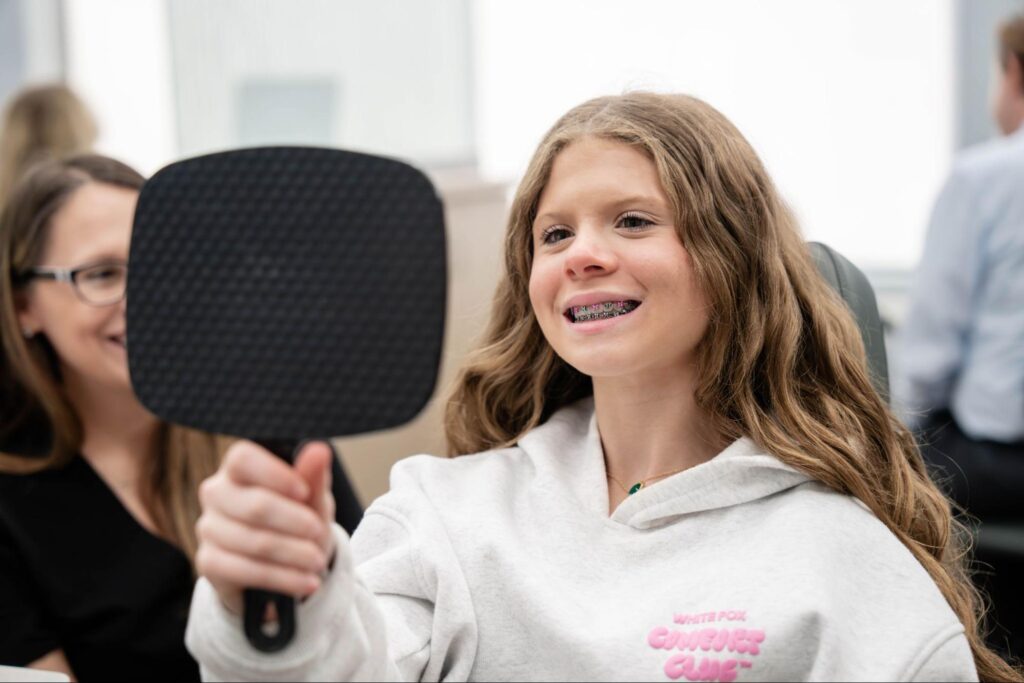When most people think about orthodontic treatment, two options usually come to mind: braces and Invisalign. Both have transformed countless smiles across St. Louis, but they work in different ways and fit different lifestyles.
At Bankhead Orthodontic Specialists, our doctors take time to explain both paths so patients can make confident choices. Whether you’re a teen, parent, or adult professional, understanding the differences between braces and Invisalign is the first step to choosing the option that fits your goals.
Shared Goals for a Healthier Smile
Both braces and Invisalign are designed to create healthy, long-term improvements. Straightening your teeth can reduce uneven wear, protect gum health, and make brushing and flossing easier. The end result is about more than looks; it’s about protecting your oral health.
At Bankhead Orthodontic Specialists, we create custom treatment plans that account for your bite, age, and daily schedule. That means the choice isn’t only about what works clinically, but also about what feels manageable in your everyday life.
Appearance, Lifestyle, And Confidence
How your treatment looks and feels in daily routines often plays a big role in your decision. Patients in St. Louis want options that not only get results but also match their personalities, jobs, and social lives.
Braces Are Always Working
Traditional braces are visible, but today’s versions are smaller and sleeker than those of the past. Ceramic braces can blend with your teeth, while color ties let younger patients add personality. Because braces are bonded to your teeth, they’re always at work, and that means there’s no extra effort required to remember them.
While braces do come with food restrictions, most patients adapt quickly. With a few changes, like avoiding sticky or hard foods, it becomes second nature. Parents often appreciate the predictability braces provide, since they don’t rely on their child remembering to wear aligners.
Invisalign Fits More Seamlessly
Invisalign aligners are nearly invisible, which is why many adults and teens prefer them. They’re removed for eating and brushing, so there are no food restrictions. For patients who attend business meetings, social events, or school activities, this can be a major advantage.
The catch is that Invisalign only works if worn 20–22 hours per day. For some patients, that responsibility is easy to handle. For others, especially younger kids, remembering to reinsert aligners after meals or sports can be a challenge.
Confidence During Treatment
Both braces and Invisalign can boost confidence, but in different ways. Braces are noticeable, but patients often enjoy customizing them and embracing their orthodontic journey. Invisalign’s subtle appearance allows patients to feel more natural in photos and conversations. Both paths can help you feel proud of your progress as you move closer to your final results.
How Braces And Invisalign Move Teeth
At their core, both treatments rely on gentle, consistent pressure to guide teeth into new positions. But the mechanics differ, and those differences influence which option may work best for you.
The Process With Braces
Braces use brackets attached to each tooth and connected by wires. At each appointment, Dr. Rodabough, Dr. Oldroyd,Dr. Ethington, or Dr. Bleyer will adjust the wires to create precise movements. These regular adjustments are what make braces especially effective for complex cases, including rotated teeth, bite correction, and severe crowding.
Because braces are fixed, patients don’t have to worry about forgetting or misplacing them. Treatment works around the clock without any extra effort. That makes braces a strong option for children and teens who may not have the discipline to keep aligners in place consistently.
The Process With Invisalign
Invisalign begins with a digital scan that maps your teeth in three dimensions. From there, a series of aligners is created to move your teeth step by step. Each aligner is worn for about one to two weeks before advancing to the next. Attachments may be added to certain teeth to give aligners a better grip and precision.
Aligners are removable, which gives patients flexibility, but also responsibility. If aligners aren’t worn as prescribed, treatment can slow down or results may be less predictable. For motivated adults or responsible teens, Invisalign can be a comfortable and effective option.
Comparing Complexity
For complex orthodontic needs—like major bite correction—braces often provide more control. Invisalign has advanced significantly and now manages many moderate cases successfully, but in very complex situations, braces may still be recommended as the most efficient path.

Cleaning, Checkups, And Maintenance
Whichever option you choose, keeping your teeth clean and attending regular appointments is essential. The way you care for braces and Invisalign differs, and it’s worth considering which routine feels easier for you.
Cleaning With Braces
Braces require extra care because food and plaque can collect around brackets and wires. Patients should brush carefully after every meal and floss once per day, often with floss threaders or water flossers. While the routine takes a little more effort, our team provides guidance and tips to make it manageable.
Appointments are usually scheduled every six to eight weeks. During these visits, our doctors adjust wires, check progress, and make sure teeth are moving according to plan.
Cleaning With Invisalign
Because aligners are removable, brushing and flossing remain the same as before treatment. Aligners themselves should be rinsed and gently brushed daily to prevent buildup. Patients should also brush after eating to avoid staining the trays.
Checkups with Invisalign may be spaced further apart than braces visits, depending on the plan. In some cases, remote monitoring is used to ensure patients stay on track between appointments. This flexibility is especially helpful for busy families in O’Fallon, Chesterfield, or Wentzville who may not want to travel as frequently.
Cost, Timeframe, And Who Benefits Most
Both braces and Invisalign can be comparable in cost, and both typically range from 12 to 24 months in treatment time. The best choice depends on your specific smile needs and lifestyle preferences.
How Long Does Treatment Take?
Most patients complete treatment in about one to two years. Simpler cases may finish faster, while more complex cases can take longer. Braces are often recommended when efficiency and precision are priorities, while Invisalign is appealing for its flexibility and comfort.
Financial Considerations
At Bankhead Orthodontic Specialists, we believe finances shouldn’t stand in the way of a great smile. We offer flexible payment plans and accept many insurance plans. Our team will review your benefits and help create a plan that works for your family’s budget.
Who Makes the Best Candidate?
Braces work for patients of all ages and can handle everything from simple to highly complex cases. Invisalign works best for teens and adults who are disciplined about wearing aligners consistently. Both options are powerful tools, and the right choice depends on your goals and lifestyle.

Ready To Start Your Smile Journey?
The best way to know whether braces or Invisalign is right for you is through a consultation. At Bankhead Orthodontic Specialists, our doctors take time to explain your options, answer your questions, and design a plan tailored to your smile.
With offices in O’Fallon, Chesterfield, Wentzville, Warrenton, Lake St. Louis, Alton, and Carlinville, expert care is always nearby. Schedule your free consultation today and take the first step toward a healthier, more confident smile.
